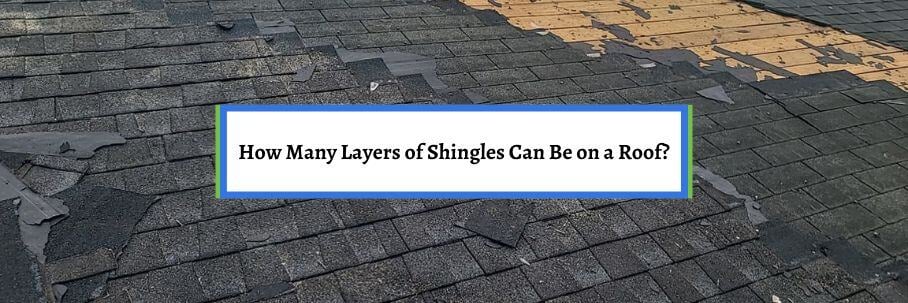How Many Layers of Shingles Can Be on a Roof?

Do you need a new roof on a shoestring budget? Are you considering nailing over your current shingles with new ones?
A roof can only have a certain number of shingle layers before a full roof replacement is required. On top of that, there are some things to consider before nailing over old shingles.
For over 30 years, Bill Ragan Roofing has prepared homeowners for their roofing projects with honest and transparent advice. So, let’s break down the number of shingle layers a roof can have and more.
By the end of this article, you’ll know:
- How many layers of shingles can be on a roof?
- 6 reasons not to nail over your old asphalt shingles
How many layers of shingles can be on a roof?
Today, you’re only allowed to have two layers of shingles on a roof in most states for fire safety reasons. So, you’ll need a full roof replacement if there are already two or more layers.
 (Roof with three layers of shingles)
(Roof with three layers of shingles)
But even if there’s only one layer, most roofs won’t be a good candidate for a nail-over reroof. The shingles themselves must be almost flat (no lifted or cracked shingles, blisters, or bumps) to nail over properly.
However, the roof must also have few penetrations, a small amount of flashing, and no walls that butt up against the shingles. Ultimately, it’s up to you and your roofing contractor to determine if nailing over your old shingles is a good idea.
Just make sure you hire a reputable local company to ensure you get honest advice. Bad or cheap roofers will do it anyway to make easy money, even if the situation isn’t right for a nail-over reroof.
6 reasons not add a second layer of shingles to your roof
It’s your decision to replace your roof or get a nail-over, but a reputable roofing contractor will recommend a full roof replacement 99 times out of 100. This isn’t just to get you to buy a roof, but nailing over old shingles actually comes with major drawbacks.
Let’s look at the 6 reasons you shouldn’t nail over your old asphalt shingles with new ones.
1. The roof decking can’t be inspected
Roof decking (also known as roof sheathing) is the foundation of a roof system. During a full roof replacement, your roofing contractor can inspect the decking’s integrity to see if it can handle your new roof after the old one is torn off.
-1.jpg?width=500&height=391&name=DeckingRotten%20(2)-1.jpg) (Rotten decking found after tearing off old roof)
(Rotten decking found after tearing off old roof)
Because the tear-off process is skipped, inspecting or replacing your decking when nailing over your old shingles can’t happen. This may not seem like a big deal, but rotten or compromised decking leads to structural issues and even potential health hazards.
That’s why a reputable roofer will always recommend tearing off your old roof.
2. A second layer of shingles adds weight to your roof
An asphalt shingle roof is heavy as is, and adding another layer doubles the weight. If the decking’s integrity is compromised, it may be unable to handle the weight of the second layer of shingles.
The fact that you can’t check the decking beforehand increases the risks even more. Now, there’s no telling how long it would take for a problem to show up.
However, the weight will cause sagging and eventually lead to structural damage that creates the potential for your roof to cave in.
3. Roof flashing can’t be replaced
Roof flashing is a crucial roofing component used that prevents roof leaks in areas where shingles go up against something, like walls, a chimney, or open valleys. I always recommend replacing your old roof flashing when getting a new roof.
However, getting a second layer of shingles means your roofer has to rely on someone else's workmanship and use your roof’s current flashing. Unfortunately, you’ll be dealing with big problems if the metal’s integrity is compromised, rusted, or the flashing is poorly installed.
This means spending even more on repairs and replacing the flashing down the road anyway, which isn't cheap. That’s why you must ask your roofing contractor if they saw any problems when considering adding a second layer of shingles.
4. A second layer of shingles covers up an aging and failing roof
The whole point of a roof replacement is to replace roofing materials and components that have reached the end of their lifespan. Like roof flashing, the other components and materials won’t get replaced when adding a second layer of shingles.
However, not replacing crucial materials and components isn’t the only problem. The main issue is the second layer of shingles covers up existing problems on a failing roof system.
These problems don’t magically go away and are still there if water gets under the new layer of shingles, which takes us to the next point.
5. Future roof leaks are harder to track and repair
Finding a roof leak takes skill to track and repair under normal circumstances on an asphalt shingle roof. Unfortunately, adding a second layer of shingles makes it much harder.
If water gets under the new layer, it goes down the old asphalt roof, finds the path of least resistance, and starts leaking inside your home. This makes it harder to find where water is coming from and then repair it to ensure the roof leak is taken care of the first time.
That’s why you shouldn’t even consider nailing over your old roof if it already has leaks and other problems only a replacement will fix.
6. You won’t get the best warranties
All asphalt shingles come out of the package with material warranties from the manufacturer. The good thing is that this doesn’t change when adding a second layer of asphalt shingles.
However, you can’t qualify for the 50-year non-prorated enhanced warranty on the entire roof system because you didn’t install the other required components. Manufacturers simply won’t warranty a roof system that doesn’t have all-new roofing components.
This means any problems or roof leaks with a two-layer roof will have to be taken care of by your roofing contractor’s workmanship warranty. Unfortunately, a roofer most likely won’t offer anything long-term because of the high potential for problems down the road.
What are the benefits of a full roof replacement?
After reading this article, you know a roof can have two layers and why it’s not recommended in most cases. However, it may be an option if your current roof is in decent enough shape and you’re in a tough spot financially.
The important thing is to talk to a reputable roofing contractor and get honest advice on whether a nail-over reroof is a viable option. But as I said, most homeowners will need a full roof replacement.
It will obviously be more expensive, but it doesn’t come with the same drawbacks. In fact, a new roof comes with more benefits than you may think.
Check out the 7 Benefits of Getting a New Roof to learn what you get when investing in a roof replacement.


